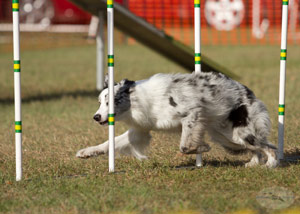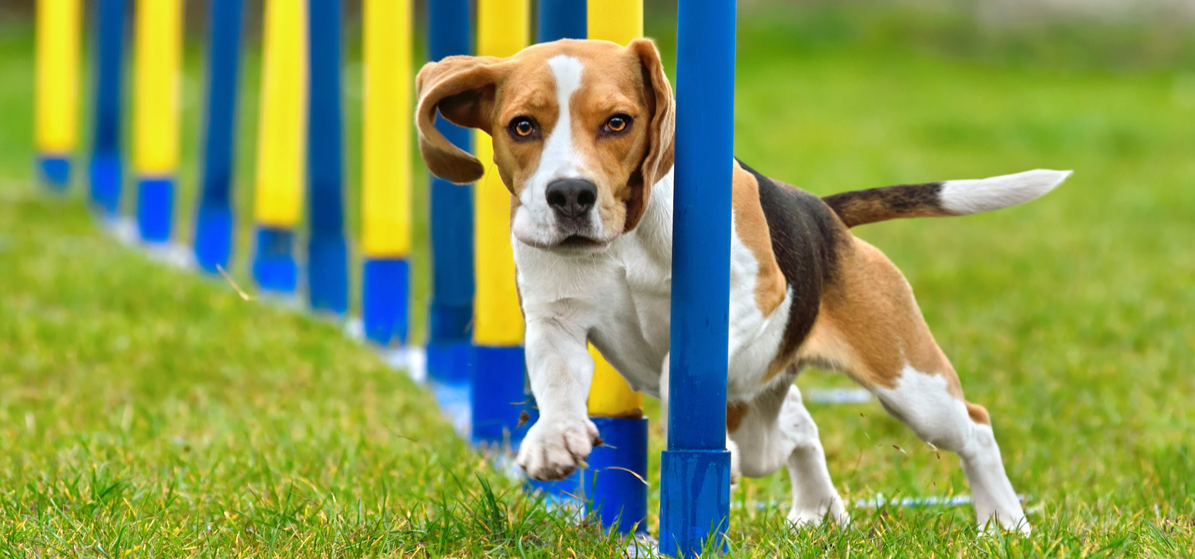By Brenna Fender

Every organization offers several difficulty levels (at least three), jump heights that are associated with the size of the dog, and most offer more than one path to titles (a Championship division which is the most difficult, a level that allows dogs to jump lower and get more time to complete the course, and possibly other divisions that are based on the age of the dog and/or the handler or other factors). In addition, a variety of classes are offered with different rules. Most organizations have a standard class that includes one of almost all of the different agility obstacles, a jumpers class that has mostly jumps and selected other obstacles, and different classes with strategy elements or distance handling portions.
In every major agility organization in the US, earning qualifying scores leads to titles that can be used as a part of a dog’s name. In a few organizations, winning over other dogs is required in order to complete high level titles.
Here’s what you need to know about some of the most popular agility associations:
American Kennel Club
The AKC offers a wide variety of dog sports to competitors, including agility. All AKC registerable breeds and breed mixes are welcome, although mixes must be spayed or neutered. Purebreds of non-AKC recognized breeds are not eligible to compete in most cases. AKC offers two divisions so that handlers can opt for lower jump heights and more time. AKC offers Standard, Jumpers with Weaves, and two other classes, Time 2 Beat (T2B) and Fifteen and Send Time (FAST), which are strategy games. AKC agility is considered to be fairly competitive and it is quite popular here in Florida . AKC’s philosophy is to keep the sport accessible to a wide variety of breeds and its jump heights and course designs supports that. AKC has held its agility national event in Florida in the past and has been home to the AKC Agility Invitational (a national event for dogs at the top of the agility rankings for each breed) for several years.
Canine Performance Events
CPE trials are open to all breeds and breed mixes and the organization does not require spaying and neutering for mixed breeds. There are six titling levels, including an entry level that doesn’t use the teeter or the weave poles (which can be challenging for novices). There are several divisions that allow dogs to jump a variety of heights. CPE offers Standard classes and a variety of games classes. CPE has become quite popular in Florida. CPE held its national event in Florida in 2010 and will do so again in 2015.
North American Dog Agility Council
NADAC has no registration restrictions based on breed or mix and does not require spaying or neutering for mixes. NADAC agility has some big differences from many of the other organizations. NADAC does not use several of the obstacles seen in other agility venues, including the teeter, tire, chute, and table. It does have several additional obstacles, like the hoop and barrel. The added obstacles do not require jumping, and jump heights are lower than in other venues (and several of the divisions allow even large dogs to jump quite low). The courses encourage speed and distance work. There are quite a few games classes that include a smaller variety of obstacles, and some require working at a distance in some portions of the course. NADAC encourages distance work in other classes as well with bonus options. NADAC allows limited training in the ring (although the run will be nonqualifying). There are quite a few NADAC trials in Florida, mostly in the cooler months.
United States Dog Agility Association
USDAA registers all dogs, regardless of breed or mix, and it has no spay/neuter requirements. USDAA offers Standard and Jumpers as well as Gamblers (a strategy and distance game), Snooker (a strategy game), and tournament classes (Grand Prix of Dog Agility and the $10,000 Steeplechase). Like AKC, USDAA offers two divisions (USDAA actually started that concept!) and additional Veterans and Junior Handler classes at some trials. Clubs may also offer Intro Classes which are designed to help very novice dogs get started or to serve as a For Exhibition Only training class (with no qualifying or placements) for experienced dogs. USDAA’s programs require dogs of some heights to jump higher than in other US agility organizations and it offers more “international style” courses than many other organizations do (these may be more challenging). USDAA’s program also requires competitors to finish in the top percentage of one of their classes (Snooker) in order to complete high-level titles. There are many USDAA trials in Florida, mostly in the cooler months.
Other Organizations
There are also other agility organizations that are up-and-coming or not quite as popular (yet) in Florida. For more information, check out Dogs on Course in North America (DOCNA), www.docna.com; Teacup Dogs Agility Association (TDAA, for small dogs only), www.k9tdaa.com; United Kennel Club (UKC), www.ukcdogs.com; UK Agility International (UKI), www.ukagilityinternational.com; and a new agility/dog disc combination competition, the UpDog Challenge, www.updogchallenge.com.

 www.usdaa.com
www.usdaa.com

